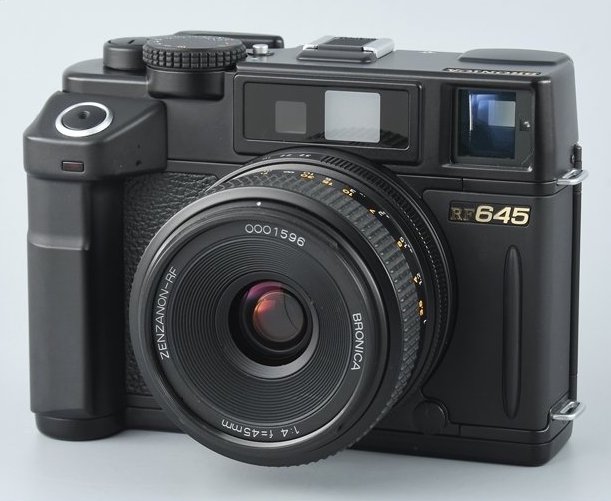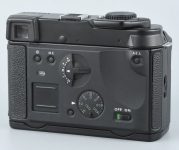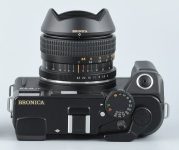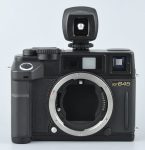Bronica RF645
Medium format MF film rangefinder camera
Specification
| Production details: | |
| Announced: | September 2000 |
| System: | ● Bronica RF645 (2000) |
| Format: | |
| Maximum format: | Medium format 6x4.5 |
| Film type: | 120 roll film |
| 220 roll film | |
| Mount and Flange focal distance: | Bronica RF645 |
| Shutter: | |
| Type: | In-lens leaf shutter |
| Exposure: | |
| Exposure metering: | Through the separate window |
| Exposure modes: | Programmed Auto |
| Aperture-priority Auto | |
| Manual | |
| Rangefinder and Viewfinder: | |
| Rangefinder: | Built-in, combined with viewfinder |
| Viewfinder: | Built-in, combined with rangefinder |
| Finder magnification: | 0.6x |
| Actual rangefinder base: | 53.5mm |
| Effective rangefinder base: | 32.1mm |
| Bright-line frames: | 65mm, 135mm |
| Parallax compensation: | Yes |
| Physical characteristics: | |
| Weight: | 810g |
| Dimensions: | 145.6x107.3x64mm |
Manufacturer description #1
TAMRON ANNOUNCES THE NEW BRONICA RF645 6X4.5 FORMAT COUPLED RANGEFINDER CAMERA WITH INTERCHANGEABLE LENSES
September 20, 2000, Photokina, Cologne, Germany-Tamron Co., Ltd. (Kazuyasu Noguchi, President) announces the RF645, a new medium format 6x4.5 coupled rangefinder camera with interchangeable lenses, released under the Bronica brand.
The new products include:
- BRONICA RF645 Rangefinder Camera
- ZENZANON 45mm F/4 (with dedicated external viewfinder)
- ZENZANON 65mm F/4
- ZENZANON 135mm F/4.5
- Dedicated Speedlight RF20
Development Background:
From the moment Tamron assumed the initiative for development and sales of Bronica cameras, the company has placed a high priority on pursuit of a new segment for the Bronica camera line. Following extensive market research, this effort has now taken shape in the Bronica RF645: a fully manual coupled rangefinder camera that is highly functional and easy to use, offering rugged durability and superb image quality that makes the most of the 6 x 4.5medium format film size.
In recent years fully automatic cameras have moved to the fore, and those in the medium format category are no exception to this trend. At the same time, manual rangefinder cameras have staged a comeback as a new generation of users begins to explore the potential of this type of camera for creating images with a more personalized touch.
The new Bronica RF645 is a camera that offers accurate, high fidelity image quality. It combines the classic handling of manually operated features with highly sophisticated electronics for an optimum balance of superior image quality, ease of operation and maximum user control.
The Bronica RF645 will be welcomed by advanced amateur photographers seeking to move beyond 35mm to medium format, as well as existing medium format users and working professionals, as the camera responds to a broad range of photographer needs.
- Employing the 6x4.5 format, the highly accessible standard among medium format cameras, the RF645 was designed for maximum compactness. Consequently, the camera combines the superior quality of the medium format with comfort and ease of handling.
- Operating dials and switches have been simplified and dedicated according to function, and are designed for maximum visibility and ease of use. The large exposure compensation dial and ISO exposure index dial are positioned on the rear panel for maximum accessibility and swift manual operation.
- In addition to the painstakingly optimized manual features, a wide variety of high-tech electronic features such as automatic exposure control have also been incorporated to ensure that photographers achieve precisely the results they envision when shooting.
- To broaden the creative possibilities for users, three high performance interchangeable lenses have been developed for the RF645.
- Upper casing of the camera chassis is made of magnesium alloy Thixomold, a highly rigid, lightweight material that will protect the delicate internal components of the RF645 for many years.
Main Features:
6x4.5 Coupled Rangefinder Camera
The 6x4.5 format is the most popular for medium format cameras. The Bronica RF645 has realized an easy to operate coupled rangefinder camera by making it as compact as possible.
Maximum Efficiency In Manual Operation
The RF645 was designed to be a practical, easy to use coupled rangefinder camera. Each of the dials and switches has been designed for maximum simplicity and size, to ensure ease of handling and enhanced visibility in a simple, straightforward design.
In particular, the exposure control functions are highly visible and well positioned on the camera back, and can be operated almost entirely by the right thumb. The most frequently used exposure compensation dial was purposely designed without a lock feature with convenience for the professional in mind.
The film advance mechanism is constructed in full manual, allowing full stroke or ratcheted advance. This is made possible by the use of an electronic lens shutter unit. Additionally, the focusing ring is intentionally designed to rotate in the same direction as the rangefinder's horizontal movement for intuitive focusing operation.
Interchangeable Lens Design
The RF645 is the first rangefinder camera in the 6x4.5 format to offer interchangeable lenses.
The three lenses designed for this camera are the wideangle 45mm F/4 (equivalent to 28mm in 35mm format), the standard 65mm F/4 (40mm equivalent), and the telephoto 135mm F/4.5 (80mm equivalent).
Aimed at producing the best possible image quality, our engineers selected the ideal optical composition for each lens. Aberrations are thoroughly corrected, resulting in superb optical performance. The 45mm lens features as standard an Albada type external viewfinder, which renders precise framing over a wide field of view.
High Precision Rangefinder
A top-level dual-image superimposing coupled rangefinder is incorporated, providing the highest level of accuracy and sharp clarity. The viewfinder displays a full view, and utilizes Inverse Galilean type optics for a bright and broad field of view.
The rangefinder is constructed with real image optics fully capable of working efficiently with the 65 mm (40mm equivalent for 35mm) and telephoto 135mm (80mm equivalent). Clear and accurate focusing is made possible with this system. The viewframe used is a bright frame with ambient light. Automatic parallax compensation ensures a viewframe that properly aligns with the image area in accordance with the focusing distance.
Efficient, Comprehensive Data Displays In The Viewfinder
The viewfinder features backlit LCD displays to indicate camera operating status and exposure information. Camera status can be monitored without looking away from the viewfinder. The viewframe switches automatically depending on the angular field of the interchangeable lens, making for optimum framing.
Easy To Use AE/Program AE Systems and Center-Weighted Average Metering
The RF645 employs program AE and center-weighted average metering system for maximum ease of use. Exposure compensation dial and AE lock button are laid out on the camera's rear panel for optimum ease of operation.
- Aperture-priority AE and Program AE: The two automatic exposure modes include both the conventional aperture-priority mode common to most medium format cameras, as well as program AE. Since capturing fleeting and precious photographic opportunities is the highest priority for photographers, program AE is one more feature that makes the RF645 the ideal choice.
- Center-weighted, average metering: Center-weighted average metering is considered to be most popular for its simplicity and ease of use, prompting Bronica to select this system for the RF645. The meter is installed on the side of the viewfinder window, using a five-segmented sensor. Differences in light distribution characteristics according to the view angle of each interchangeable lens are compensated for. Whether with wideangle or telephoto, this system measures the light in a well-balanced way.
- Large Exposure Compensation Dial: The RF645 incorporates a highly visible and easy to operate large sized exposure compensation dial-on the center of the camera's rear panel. This design, taking into account the importance for rangefinder camera users of capitalizing on split-second opportunities, puts quick and appropriate operation first, and by avoiding the dial lock design enables simple operation with the right thumb only. Compensation steps are 1/2 EV, and while in operation the LCD display in the viewfinder displays a "+" or "-" warning symbol.
- AE Lock: For speedy shooting, functionality of AE lock is critical. The AE lock button features toggle switch operation, and once activated the exposure data will be retained and flashed on the LCD panel display. The photographer can then take as many shots at this setting as desired, without fear of the AE lock setting being released unexpectedly. (AE lock settings will be cleared only after five minutes without use or if the main switch is turned off.)
Fully Electronically Controlled Lens Shutter Unit
The shutter utilizes a fully electronic control system for the aperture control and shutter charge operations. An actuator incorporated in the unit commands this newly developed shutter.
The interface between the lens and camera mount section is performed by an electronic connection, ensuring fully electronic control of the exposure systems between lens and camera. This makes incorporation of the program AE possible, which was difficult with conventional lens shutter unit systems. Unlike traditional lens shutter units, there is no mechanical spring tension involved, resulting in a quieter, more stable shutter action.
Auto Charging System:
A More Practical Shutter Release The RF645 features an automatic shutter cocking system that charges the shutter automatically immediately after shutter release. This shutter unit conducts shutter charging independently from film advance operation, and the system is sequenced so that charging takes place as soon as the shutter completes a open/close cycle. Through use of this system, a comfortable shutter action can be enjoyed similar to automatic film winding cameras, while meeting with the manual film advance mechanism both in full stroke and rocketed operation.
Top Speed of 1/750th Second
Through employment of a fully electronic lens shutter with its stable, regulated shutter speed, our design engineers have succeeded in achieving a maximum shutter speed of 1/750th of a second (only in Program AE with an aperture setting of F/22.).
Newly Developed Light Shielding Curtain To Prevent Accidental Film Exposure
In order to prevent exposure of the film when changing lenses, a light shielding curtain is activated when removing and replacing lenses. This newly developed structure facilitates swift interchange of lenses.
A Solid, Appealing Metal Casing and Magnesium Alloy Top Cover
The RF645 employs a large proportion of metal components in the body construction to ensure solid structural strength as well as quality feel and handling characteristics. The front plate which serves as the main body frame and interchangeable lens mount is die cast, the bottom plate is of brass and the top cover which houses the rangefinder is of hard, lightweight magnesium alloy. The leading edge magnesium Thixomolding* injection method is employed to give the casing the hardness of metal and a complex shape required for this innovative design: one that cannot be attained through conventional press stamping.
*Unlike conventional high temperature, high pressure die casting, magnesium Thixomolding is achieved by injecting near-solid magnesium alloy chips into metal molds, much like the plastic injection molding process. This method prevents temperature warping and requires little finishing work, thus making it ideal for line production. Since the injection mold is used, this method also allows for great freedom of shape in product design.
Manufacturer description #2
Camera Type: Coupled-meter rangefinder, lens shutter 6 X 4.5 format camera
Picture Format: 41.5 mm X 56 mm
Film: 16 frames on 120 type film, 32 frames on 220 type film
Shutter: Bronica No. 00 type electronically controlled lens shutter in each lens, shutter speeds: B, 1 to 1/500 sec. (on manual without intermediate speeds), 8 to 1/500 sec. (on aperture-priority AE mode, 1/12-stop increment control), 8 to 1/750 sec. (on programmed AE mode, 1/12-stop increment control). Electronically timed self timer with 10 sec. delay time
Advance: By rapid winding lever placed on top of camera with either 186 deg. single stroke or ratcheted strokes, with 12 deg. standby angle
Rangefinder: Dual-image superimposing real image optical system, with 53.5 mm base line (effective base line: 33 mm)
Viewfinder: Inverse Galilean optical system with coupled rangefinder bright frames automatically switched between 65 mm and 135 mm lens and automatically corrects parallax, finder magnification 0.6X, viewing field 81% at 3 m
In-Finder Display: Shutter speeds, lens aperture, correct exposures, flash ready, exposure compensation warning, AE L warning, multiple exposure (ME) warning
Exposure Metering: Center-weighted area-comparative metering system, metering range EV 3 to EV 18 (65 mm f/4, ISO 100), film speed range: ISO 25 to 1600, exposure compensation range: +2 to -2 EV (1/2-stop increment)
Exposure Control Modes: Manual, Aperture-priority AE and Programmed AE modes
Battery: 2 cells of CR2, 3V Lithium type battery
***
The RF645 features a high accuracy, easy to view dual image superimposing rangefinder. The rangefinder employs a superb quality real image optical system using mechanical and optical components of the highest precision design and manufacture. Focusing is clear and precise. The readily visible bright frame technology utilizes automatic parallax compensation that adjusts the frame to the point of focus for optimum framing.
In addition to Aperture-priority AE and full manual mode, the on-board metering system provides Program AE mode that makes it possible to capture those once in a lifetime images. All of the camera controls are available at your fingertips creating the perfect balance between automatic and manual control.
The entire system is engineered with key devices such as a newly developed super silent electronic lens shutter and an automatic light shielding curtain, which is activated whenever a lens is removed from the camera.
The shutter unit operations including shutter blade action, diaphragm movement and shutter recharge are all electronically controlled by an actuator inside the unit. This represents Bronica's first fully electronic shutter system.
A major difficulty increating an interchangeable lens with built-in shutter is that the camera body construction must prevent the film from being exposed when switching lenses. The lens removal and attachment mechanism activates a light shielding curtain to automatically cover the fil m surface.
It's no secret that a simple design is often the most effective. Combining rugged construction with intuitive control placement creates an instant bond between the RF645 and you.
At Bronica, we have never considered the camera to be a mere tool of the trade for photographers. True professionals form a special bond with their cameras, a kind of partnership, working together to capture precious scenes that may never come again. The feel, the handling, the action: all these combine to make the camera much more than just a meansof shooting photographs.
When we set out to design the RF645, our goal was to create a camera that photographers would love to handle, that would lead them into new creative territory. We aimed to design a new kind of rangefinder camera. In the RF645, we think we have succeeded.
Serious about combining structural strength with superior design and handling, we turned to advanced metal alloys for much of the body casing. The main body and front facing are die cast, the bottom plate is of brass, and the upper housing enclosing the viewfinder and integrated rangefinder mechanism is made of magnesium alloy.
Manufacturer description #3
BRONICA MEDIUM FORMAT BUSINESS TERMINATED
Rapid Shift to Digital SLRs by Bronica’s Core Customer Base Prompts Move to Terminate Bronica Medium Format Business
October 14, 2005, Commack, New York — Tamron USA, Inc. announced today that it has discontinued the production of the Bronica RF645 6x4.5 range finder camera model along with its relevant interchangeable lenses and accessories. The discontinuation of this last Bronica model marks the termination of the Bronica brand business. Bronica withdraws from the medium format camera business after 47 years since its first model, the Zenza Bronica D, was introduced in 1959.
Due to the drastic worldwide shift to digital over the past few years, medium format business has suffered, particularly in the portrait and wedding photography segment, the core customer base for Bronica cameras. “I believe we all understand the issues at hand when it comes to the business of medium format,” stated Kenji Nakagawa, Sales Manager of Tamron headquarters’ Overseas Sales & Marketing Department in Japan. “We have been struggling to find the best possible solution for the medium format camera business under the Bronica brand, but after careful study and the comprehensive consideration of the market situation, we have concluded that there is no other choice but to end this business.”
Bronica sales have drastically dropped as age of digital photography rapidly eclipses the film era. The quick adoption and shift to digital technology by the core Bronica customer, professional portrait and wedding photographers, accelerated the decline in Bronica business faster than other brands of medium format equipment. “For many years, Bronica cameras have been the workhorses used to photograph hundreds of thousands, perhaps millions, of weddings around the world,” stated Stacie Errera, Chief Marketing Officer for Tamron USA, Inc. “However, for these photographers, who collectively made up a huge percentage of our installed customer base, digital SLRs produce satisfactory image results, higher creativity options and increased profits (after the initial issues of workflow and printing were worked out by most), which made the switch to digital almost unanimous among this group of professional photographers.”
Tamron USA, Inc. is fully prepared to carry on servicing Bronica equipment for seven years from the official date of discontinuation of each model. “While I understand the market situation and the need to discontinue the Bronica line, I must admit that I was a little disappointed,” stated Pat Simonetti, Technical & Customer Service Manager of Tamron USA, Inc. “We are well prepared to continue servicing our users and thank them all for their support over the years.”




